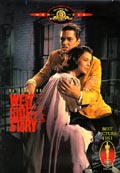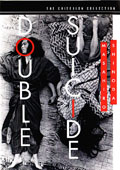|
“Mad Blood Stirring” (p. 2)
by Eleanor M. Farrell
|
The three films discussed above are all straight adaptations of Shakespeare’s play. Scenes and dialogue may be cut, and setting and costumes varied, but the characters are still called Montague and Capulet. In 1957, a stage musical with choreography by Jerome Robbins, music by Leonard Bernstein and lyrics from Stephen Sondheim took Broadway by storm. West Side Story transported Shakespeare’s Romeo and Juliet to New York City amidst a turf war between two gangs, the white American Jets and the Puerto Rican newcomer Sharks. The 1961 film adaptation, with Natalie Wood and Richard Beymer as lovers Maria and Tony, is the quintessential American version of the familiar story (1). The racial tension stemming from a chronology of immigrant waves into the City is the unconquerable force of the tragedy, as Tony and Maria attempt to make peace between their “families.” West Side Story gives more space to developing other characters, such as Maria’s volatile brother Bernardo and his lover Anita, which broadens the story beyond the fate of a single couple.
|
 |
This is a story of youth, with the candy store owner Doc, Tony’s employer, the only visible representative of an older generation. Even the legal establishment adds to the impending tragedy: beat cops Lieutenant Schrank and Officer Krupke are openly racist, encouraging the Jets to defeat their Puerto Rican rivals. Finally, the story does not end in suicide (although there’s more than a hint of suicidal tendency when Tony is falsely told that Maria has been shot and goes looking for her killer). After Riff (Mercutio) and Bernardo (Tybalt) are stabbed to death in a rumble, Tony is shot by a jealous and enraged rival gang member and dies in Maria’s arms. The shocked members of both gangs then join together to carry away Tony’s body. This change to the play’s ending — when so much else has been retained — demonstrates an optimism specific to American culture in the fifties, a deliberate choice to mitigate the tragedy with more hope than the reconciliation scene in Shakespeare’s play allows, by showing the reactions of the youthful gang members rather than their (non-existent here) elders. Contrast this with the ending of the ’90s Luhrmann version of Romeo and Juliet, where there is no indication that the gang warfare will ever end, even after the tragic death of the two leaders’ children. |
Shakespeare is held in high esteem in Japan; stagings of the plays have been documented since the late nineteenth century and often use Japanese cultural forms in order to make the stories particularly relevant. Cinema found an early audience in the island nation, and the symbolic codes of Bunraku (puppet theater), which utilizes a narrator to declaim the plot, was an ideal fit to silent films. The most prominent Japanese film director influenced by Shakespearean plots is undoubtedly Akira Kurosawa, whose Throne of Blood, The Bad Sleep Well, and Ran form a trilogy of adaptations of Shakespeare tragedies — Macbeth, Hamlet, and King Lear respectively. No Japanese cinema director has tackled Romeo and Juliet, but one seminal film from New Wave auteur Masahito Shinoda uses some of the familiar tropes. Double Suicide (1969) is based on a Bunraku play by Monzaemon Chikamatsu (who is often referred to as the “Japanese Shakespeare”) called The Love Suicides at Amijima. The male protagonist, Jihei (Kichiemon Nakamora), has fallen in love with a courtesan, Koharu, and in trying to “redeem” her — i.e., pay her debts so that she can be free of this profession — has driven himself and his family into financial and emotional ruin. Finally, Jihei’s wife is taken away by her father and Koharu is bought by an unsavory client, so the lovers decide that their only release is to die together. Shinoda felt that fate was inevitable, and there is no hint of salvation for the lovers of Double Suicide. Their deaths, unlike those of Romeo and Juliet, are not accidental: after symbolically releasing themselves from worldly obligations by cutting their hair, Jihei and Koharu make love one last time in a cemetery; then Jihei stabs his lover with a sword and hangs himself.
|
 |


|
There is no “feud” aspect in Double Suicide: society is against the lovers here, but in a more impersonal, and also a more personal, way than the chaotic actions of the warring clans of Romeo and Juliet. Jihei’s wife (who, intriguingly, is played by the same actress who plays Koharu, Shima Iwashita), has suffered from her husband’s obsession and even begs Koharu to release him. The realities of a courtesan’s life in Japanese culture give Jihei’s more wealthy rival every right to redeem her for himself. Thus, the tragedy of these lovers stems from their own sexual/emotional obsession and their willingness to defy society to be together, even if this can only be in death. The use of Bunraku puppets — the story is set within a frame of preparations for a Bunraku play, and kuroko (puppet manipulators dressed in black) appear in scenes throughout the film — emphasizes the position of the humans as helplessly controlled by fate. Love (ninjo) versus duty (giri) is the plot of almost all Japanese classical drama, and both director and playwright share the fatalistic view that man is incapable of escaping destiny.
|
|
| (1) More recent efforts at an updated approach, such as China Girl or Romeo Must Die — both of which introduce an Asian component into racial gang conflict and as such could offer interesting insights into changing American culture — lack development of the Shakespearean themes, among their other faults. |
|
|
Next, 2, 3, 4, 5 |



